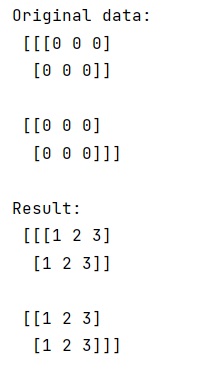Home »
Python »
Python Programs
numpy.full_like() Method with Example
Learn about the numpy.full_like() method with its usage, syntax, and example.
By Pranit Sharma Last updated : December 28, 2023
Description and Usage
The numpy.full_like() method returns a new array with the same shape and type as the given array and fills the array with the "fill_value" value. It is like numpy.full() which returns a new array of a given shape and type and it fills the array with the "fill_value" value.
Syntax
numpy.full_like(a, fill_value, dtype=None, order='K', subok=True, shape=None)
Parameter(s)
- a: array-like value, the shape and type of a will be the shape of the type of the output.
- fill_value: The values which need to be filled in the array
- dtype: It is optional, if given, it overrides the default data type
- order: It is an optional parameter and used to override the memory layout of the result.
- subok: An optional and Bool type parameter. If we set it to True, then newly created array will use the sub-class type of a, otherwise it will be a base-class array.
- shape: An optional and int or sequence of ints type. It is used to override the shape of the result.
Return Value
This method returns an Array of fill_value with the same shape and type as a.
Example: Python code to demonstrate the example of numpy.full_like()
# Import numpy
import numpy as np
# Creating a numpy array
arr = np.zeros([2, 2, 3], dtype=int)
# Display original data
print("Original data:\n",arr,"\n")
# Creating a full array like arr
res = np.full_like(arr, [1, 2, 3])
# Display result
print("Result:\n",res)
Output

In this example, we have used the following Python basic topics that you should learn:
Reference
numpy.full_like
Python NumPy Programs »
Advertisement
Advertisement